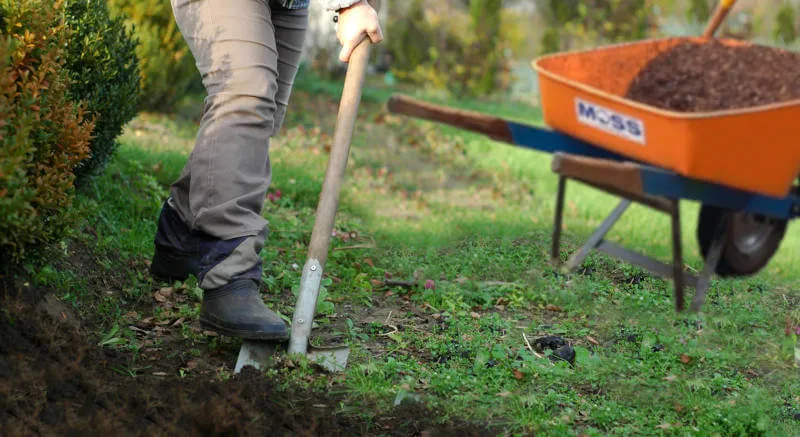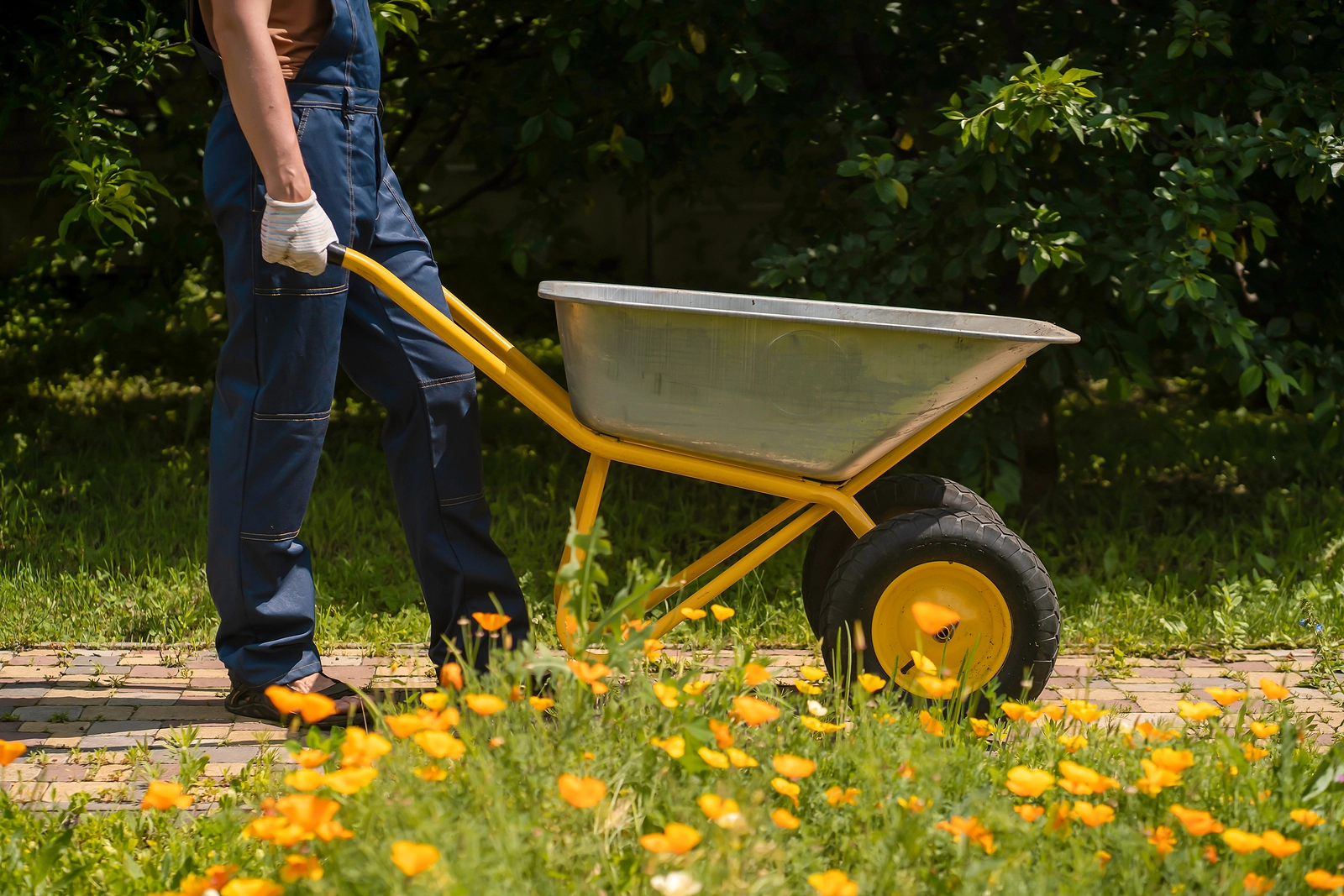Are you in the market for a commercial wheelbarrow? Choosing the right wheelbarrow is vital if you want to ensure that your landscaping tasks are completed efficiently and with minimal effort.
Discover what features to look out for and make the best choice for your needs in this comprehensive guide. You will learn all about choosing the best commercial wheelbarrow for your needs.
The purpose of this guide is to provide an overview of commercial wheelbarrows and the factors to consider when selecting and purchasing one. A commercial wheelbarrow is an essential part of any worksite, especially those involving the transport of large amounts of various materials. It is important for buyers to understand the features available in the market, as well as pricing and other considerations when making a purchasing decision. This guide provides a comprehensive look at commercial wheelbarrows and all their associated components, so you can be sure you are selecting the best product for your needs.

Material of Construction
When buying a wheelbarrow for commercial applications, it is important to consider the material of construction. You want to make sure that it is sturdy enough to carry the loads you intend to move without being too heavy or cumbersome. Commonly used materials for commercial wheelbarrows include metals such as steel and aluminum, with steel being the more popular option due to its superior strength and load capacity. Aluminum is also a good choice because of its lighter weight and resistance to rust, but it may not be able to handle particularly heavy loads. Wood is also sometimes used for making wheelbarrows, however these are generally used in landscaping or gardening applications where lighter loads are usually moved.
No matter what material you choose, make sure that it has a quality finish and has been treated with protective coatings or sealants such as paint or powder coating in order to reduce corrosion from water and other environmental causes. Also take note of things like ergonomic handle designs and easy-grip materials that can make your job easier so that you can get more done with less effort.
Steel
When you are looking for a commercial wheelbarrow, one of the primary considerations when buying is the type of material used in its construction. Steel is by far the most widely used material as it is strong, relatively lightweight and cost efficient. However, there are several types of steel to look out for.
First are load-bearing models with a variety of gauge thicknesses available. Typically, the thicker the gauge steel – that is the number indicating its strength -the higher quality and therefore more expensive it will be. While thinner gauge steels may suffice for domestic use or lighter weight applications, commercial wheelbarrows should have a minimum thickness to ensure long life expectancy and safe usage for heavier loads; typically around 10ga to 12 ga is considered suitable for most applications.
Also important is whether or not galvanized steel has been used for added protection against rust and corrosion –essential if being operated in wetter climates or working conditions involving water such as laundry rooms or swimming pool maintenance operations. Galvanised finishes offer greater resilience and durability to outdoor environments while also preventing any limited tensile strength which occurs due to roller expansion during cold weather months; this can cause bending or warping which reduces rim longevity over time without proper protection.
Plastic
Plastic wheelbarrows come in a variety of styles and sizes to suit different needs. Smaller plastic wheelbarrows are created for light-duty tasks such as transporting bags of compost or mulch, while larger versions are designed to handle heavier loads.
The plastic trays on these models can be removable or non-removable, depending on the make and model you choose. Plastic wheelbarrows may also have additional features such as tool mounts or built-in hooks designed to hold tools securely while you’re working.
The frames can also vary depending on the purpose of your wheelbarrow; some are designed for general garden use, while others may be built to stand up to punishing professional workloads.
Wood
When it comes to choosing a commercial wheelbarrow, the most important factor is the quality of the materials. Wood is often used for wheelbarrows and is a good choice due to its durability and strength.
Wooden wheelbarrows are constructed of kiln-dried hardwood like oak that can be either stained or painted. Oak typically lasts longer than other woods because it is naturally more resistant to weathering and warping. Other hardwoods like spruce can also be used, but they may not last as long as oak.
While some wooden wheelbarrows may come pre-assembled, others may need to be put together. In both cases, ensure that all lumber used is properly dried and sanded with no visible knots or warping before assembling. Additionally, screws must be used rather than nails when constructing a wooden wheelbarrow so that it can withstand heavier loads without breaking apart.
III. Stability and Maneuverability
When shopping for commercial wheelbarrows, it’s important to consider both stability and maneuverability. Generally speaking, the more stable the construction and design of the wheelbarrow is, the less likely it will tip or be difficult to maneuver. Of course, maximum stability comes at a cost as models designed for heavy-duty jobs tend to be heavier themselves.
Consider features such as wider and deeper trays with reinforced bottoms, four-corner balance design, large capacity wheels with treads that provide stability and better traction on uphill or wet surfaces. These features will generally make pushing cumbersome loads much easier. You can also look for extra handle height which increases leverage when using the wheelbarrow on surfaces that feature varying ground levels or uneven terrain.
Stability
When selecting a commercial wheelbarrow, it’s important to consider stability and maneuverability. Many commercial wheelbarrows are made from heavy-duty materials such as steel or aluminum, which makes them ideal for heavier loads while still remaining durable and balanced. Look for models that feature wide, flat beds and large wheels with stability-enhancing ball bearings. Additionally, look for strong axle hubs, as this will enhance the overall sturdiness of the wheelbarrow, resulting in a smoother ride and less user fatigue over time.
Additionally, you’ll want to check the positioning of the handle – be sure it is comfortable enough to allow you to control the barrow’s movement without strain on your back or arms.

Maneuverability
Maneuverability is a key factor in choosing a wheelbarrow. Make sure it suits the job that you are going to use it for, whether at home, on a farm or at a construction site. The wheel size and number of wheels both affect how easily you can maneuver the wheelbarrow in different terrain.
The size of the wheel affects how much strain the wheelbarrow puts on your body when pushing, it also affects how easily you can turn corners and how close it can get to objects and walls. Generally, wheels that are smaller than eighteen inches make pushing harder because they absorb more bumps and reduce traction. If you have issues with your back, choose a wheel size closer to twenty four inches as this will help lessen the amount of strain on your body when pushing the wheelbarrow.
Two-wheeled designs provide significantly more stability than one-wheeled design but require more effort to maneuver, especially when turning corners or traversing uneven areas such as gravel driveways or muddy fields. If you plan on using the wheelbarrow in rough terrain like these, consider getting a four-wheeled design for better maneuverability and stability. A four-wheeled design will also help keep the load balanced compared to two-wheeled designs which tend to tip over easier due to uneven weight distribution or unstable materials such as mulch.
Factors that affect stability and maneuverability
When you purchase a commercial wheelbarrow, remember that maneuverability and stability are two of the most important variables. There are several factors that contribute to this issue.
The first factor is load weight. A full commercial wheelbarrow can weigh between 65-120 lbs., depending on the material and construction. A lighter load makes it easier to maneuver around obstacles or other workers, but a heavier load becomes much more stable when being pushed over uneven terrain. The second factor is the number of wheels; a four-wheeled chassis provides increased stability and traction, while a two-wheeled design is easier to maneuver in tight spaces. The type of terrain you plan to navigate will partly determine which design works better for your situation.
Thirdly, look at the size of the wheels and tires; larger wheels provide better traction on slippery surfaces or loose gravel, while smaller tires offer smoother movement on hard surfaces such as concrete or bricks. Finally, consider the weight distribution system: many models feature dual handles with an off-center weight distribution system so that pushing power is evenly distributed across both handles for easier maneuverability without causing any shoulder strain. Each handle should be adjustable so that it fits your arm length comfortably while pushing or turning the wheelbarrow in tight spaces or narrow doorways.
All these factors combined can make the difference between difficulty and ease when purchasing your next industrial wheelbarrow.
Maintenance and Care
It’s important to care for your wheelbarrow and keep it in good working condition. Depending on the type of wheelbarrow you purchase and the materials it is made of, there are a few steps you should take when cleaning and maintaining it. Regular maintenance will ensure your wheelbarrow lasts for years to come.
First, clean the wheelbarrow regularly after use. Dirt, debris, and other materials can easily accumulate on the surfaces from exposure to different elements like dust, rain, etc., so using a new or lightly dampened cloth can help keep it clean. Make sure to wear protective gloves while cleaning as needed.
Second, lubricate any moving parts on the wheelbarrow such as wheels or rollers regularly. This helps ensure proper operation and extend the life of these components by reducing friction between them as they move over various surfaces in use. Use a light machine oil or other type of suitable lubricant designed for such purpose before each usage session.
Finally, inspect any clips or attachments on a periodic basis to make sure they are firmly in place and holding the wheelbarrow together securely; replace those that are broken or damaged as needed with an exact model replacement part available through most retail outlets that sell similar products. With regular care, you will be able to enjoy years of trouble-free use from your wheelbarrow!
Cleaning
Regardless of what you are using the wheelbarrow for, keeping it clean is an important factor in lengthening its lifespan. A key indication of a well-maintained wheelbarrow is that it should have no rust spots. If you can see any rust, there may be higher levels of degradation on the inside or other unseen areas that do not show up to the naked eye.
It’s also important to inspect the variouswheels and associated parts closely. Any bearings present should be cleaned, greased and inspected regularly (check your owners manual for recommendations). Cleaning a wheelbarrow involves wiping down surfaces with soap and water on a regular basis, as well as keeping up general maintenance of all parts. Regular cleaning helps maintainperformance and reduce wear-and-tear on bearings, screw joints and other components while also removing potential hazards such as mud or loose stones that could damage wheels or get stuck in hinges.
Lubrication
Another key factor to consider when buying a commercial wheelbarrow is how it is lubricated. Many contractors prefer to use oil based lubricants, as they are water-proof and can provide more endurance than other types of lubricants. However, certain types of lubricants are specifically designed for different materials such as rubber, plastic and metal. It’s important to make sure that the wheelbarrow you choose is compatible with the type of lubricant you use so that it won’t cause any damage to the surface.
Additionally, some wheelbarrows require more lubrication than others depending on how often the wheelbarrow will be used and what type of terrain it will be used on. Lubricated wheels can help extend the life of your wheelbarrow by reducing wear on its parts and ensuring smoother operation.
Storage
Storage can be a major factor when selecting wheelbarrows from the commercial range. Some wheelbarrows may not fold or collapse, while those that offer some kind of folding or collapsible frame are ideal for reducing bulk and making it easier to store the wheelbarrow when not in use.
Other considerations include choosing between plastic and metal material types, as well as looking at weather resistance in order to ensure that your wheelbarrow is sturdy enough to resist rusting or other damage due to extreme temperatures.
It’s also important to make sure that any collapsible frame is easy to operate and stow away quickly so you can get back to work quickly with minimal effort.

Conclusion
In conclusion, commercial wheelbarrows must be selected with care, considering the many factors that go into making them a great investment for a business. When choosing a wheelbarrow for your business, consider how you intend to use it, including weight capacity and terrain needs. Be cautious of purchasing cheaply made wheelbarrows as they may not stand up to the wear-and-tear of the job site. Depending on your needs, an axle type or solid rubber tire wheelbarrow may be preferable. Ultimately, selecting the right wheelbarrow will save time and money while lowering any potential safety issues.
FAQ’S
What should I look for in a wheelbarrow?
- Capacity
- Material (Plastic or metal)
- Wheel Type (Pneumatic or Solid)
- Wheel Size
- Handles (Grip and Length)
- Stability
- Durability
- Maneuverability
What is the best brand of wheelbarrow?
There are several good brands of wheelbarrows such as:
- Jackson
- Ames
- True Temper
- Gorilla Carts
- Rubbermaid
Which is better a plastic or metal wheelbarrow?
It depends on the usage and preference.
- Plastic wheelbarrows are lightweight, rust-free, and ideal for light-duty tasks.
- Metal wheelbarrows are sturdy, durable, and great for heavy-duty tasks.
What are the different types of wheelbarrows?
- One-wheel wheelbarrows
- Two-wheel wheelbarrows
- Electric wheelbarrows
- Folding wheelbarrows
- Garden carts
How many kg is a standard wheelbarrow?
A standard wheelbarrow has a capacity of 60-100 kg.
What is the problem of wheelbarrow?
The problem with a wheelbarrow is that it can be difficult to maneuver on rough or uneven terrain, and it can be prone to tipping over when loaded improperly.
How many Litres is a standard wheelbarrow?
A standard wheelbarrow has a capacity of 80-120 liters.
How many liters is a standard wheelbarrow?
A standard wheelbarrow has a capacity of 80-120 liters.
What gauge steel is a wheelbarrow?
A wheelbarrow can be made from different gauge steel, but typically, it is made from 16-gauge or 18-gauge steel.
Is a 1 or 2 wheel wheelbarrow better?
It depends on the usage and preference.
- One-wheel wheelbarrows are ideal for narrow areas and easy to maneuver on flat surfaces.
- Two-wheel wheelbarrows are more stable and suitable for heavier loads and uneven terrain.
See more-
- Best folding wheelbarrow 2023
- Best wheelbarrow for moving rocks 2023
- Best heavy duty wheelbarrow 2023
- Best lightweight wheelbarrows 2023
- Best wheelbarrow for mud 2023

Richard Tolliver is a seasoned author and the CEO of a popular wheelbarrowdepot and informative website. With a degree in Horticulture from the University of Missouri, he worked as a professional landscaper and garden designer for several years. His website, founded in 2010, offers comprehensive and unbiased reviews of the best wheelbarrows available in the market, helping readers make informed decisions based on their needs and budget. His expertise and knowledge have been recognized by industry professionals, and he continues to inspire gardening enthusiasts and outdoor enthusiasts alike with his personal experiences and tips on creating beautiful and sustainable outdoor spaces.

